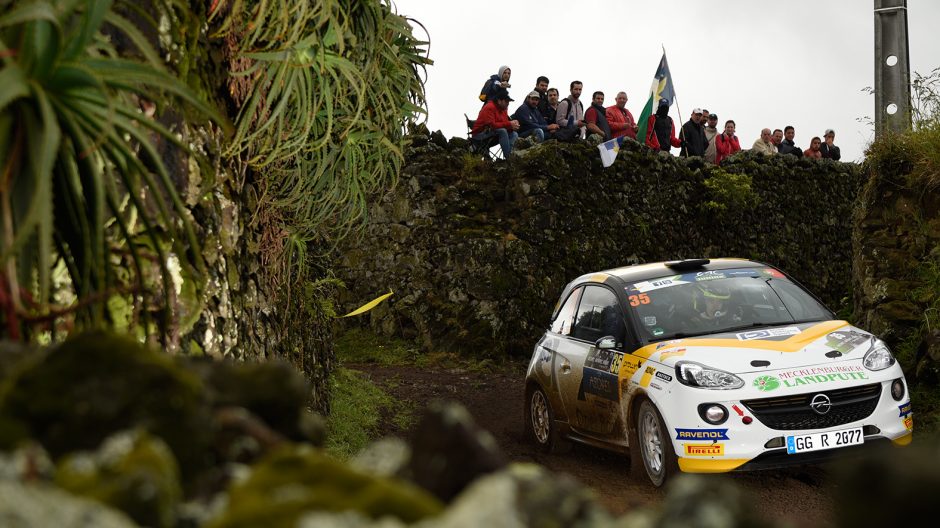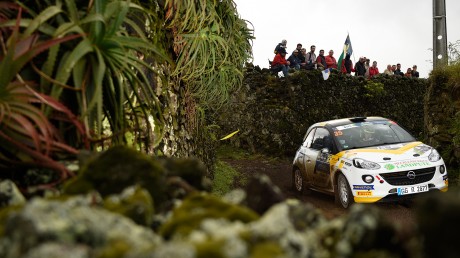The Azores is a 2,346-square-meter archipelago in the North Atlantic Ocean. The island group took its name from ‘Ilhas dos Açores’ in Portuguese, or Islands of the Goshawk. The archipelago comprises nine major volcanic islands and numerous islets. Officially they are an autonomous region of Portugal, and Ponta Delgada on São Miguel is the capital. The region features wild, undisturbed native vegetation and numerous dormant volcanoes, of which the twin lake complex of Sete Cidades is the most well known. The warm currents of the Gulf Stream make this area of the Atlantic highly productive in terms of fishing.
IT HAS NOTHING TO DO WITH IGNORANCE
Europe’s ‘weather kitchen’ brews up its mix here, nearly 1,400 kilometers west of Portugal and another 4,400 kilometers away from the eastern seaboard of the United States. In Europe, the Azores High is rather popular, especially when it wins the battle against the Icelandic Low. Then again, when Chris Ingram (21, Manchester, England), Julius Tannert (26, Zwickau, Germany), and Marijan Griebel (27, Hahnweiler, Germany) hear ‘Azores,’ their thoughts don’t turn to its geographical location, nor does the word evoke thoughts of the stunning beauty of this ambivalent archipelago. It has nothing to do with ignorance; rather, it has everything to do with absolute focus.
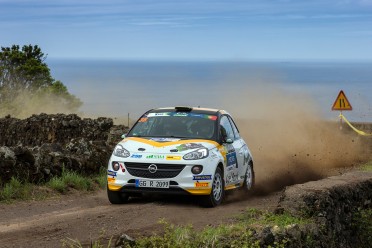
The narrow gravel tracks of the Azores Airlines Rallye are fantastic, fast, and extremely challenging.
The three drivers from the Opel plants first think of the second campaign of the season in the FIA ERC Junior Championship series. Or of the 190-horsepower Opel ADAM R2, which is currently the most successful rally car of its category. Or of the narrow gravel tracks with their fast, extremely challenging sections. And when they hear ‘Sete Cidades,’ their thoughts turn to a special stage – one that is unparalleled in the rally world. It demands ultimate concentration as they wind around numerous curves along more than 25 kilometers along the caldera. Where else in the world is the track flanked by sheer stone wall and endless drop-offs?
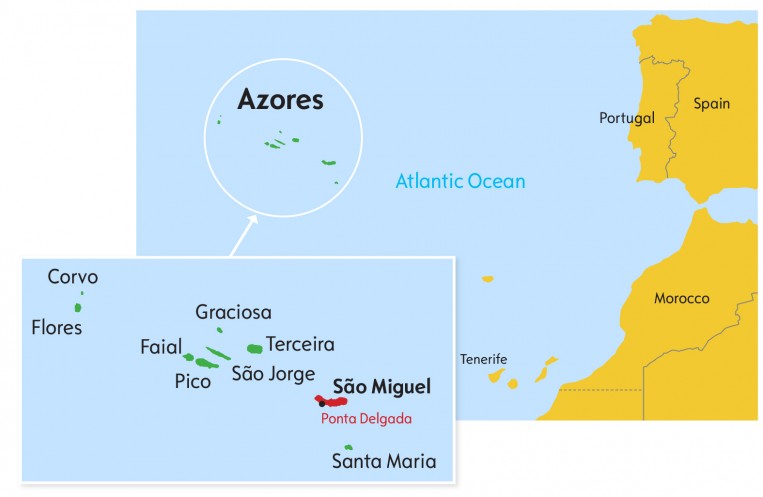
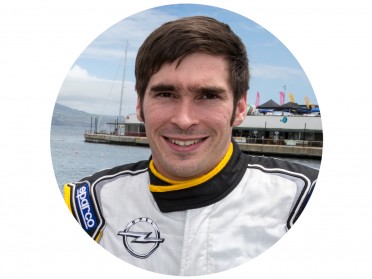
“You don’t think about what could go wrong when you’re racing.”
– Marijan Griebel –
Fear doesn’t ride as a passenger in the vehicle, not if Marijan Griebel’s behind the wheel. “You don’t think about what could go wrong when you’re racing,” he says. As he points out, the sheer rock walls upon which the spectators are perched act as a very effective boundary. “Once you’ve crested the volcano, you’re not as fast because the event organizer has also set out bales of hay as guard rails. So I don’t feel like I’m going to tumble down over the edge of a cliff. But there’s no question about it, the rally is certainly a challenging one.”
ONE PLOTS THE COURSE, THE OTHER PLODS DOWN IT
Challenging? That’s an understatement, if anything. Any driver of your garden-variety roadway system would pale at the thought of what happens on the Azores during the three-day rally competition, and, in particular, when it comes to the special stage of Sete Cidades. It is literally like dancing on the edge of a volcano, a very touch-and-go process pursued by two people who attempt to move from A to B as quickly as possible in one of the competition vehicles. Essentially, the division of labor is: The one plots the course, the other plods down the course.
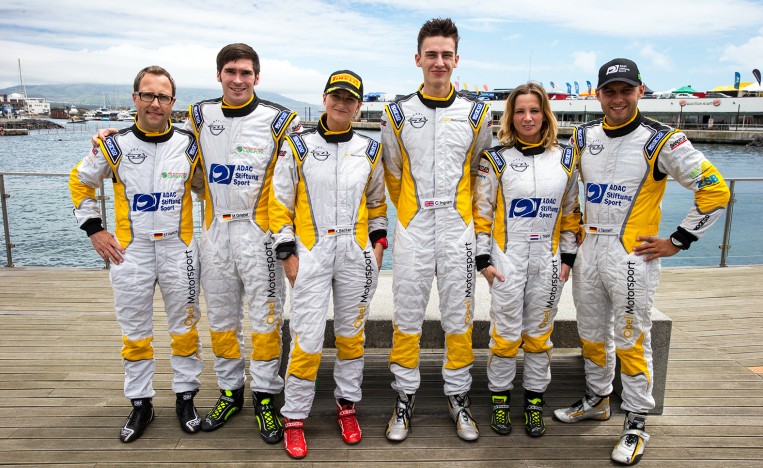
Three Opel teams with six outstanding talents (from the left): co-driver Stefan Kopczyk and his driver Marijan Griebel, Katrin Becker and Chris Ingram, and Jennifer Thielen (co-driver) and Julius Tannert (driver).
Katrin Becker (35) is well known on the rally circuits of Germany as an experienced co-driver. Originally from Schlitz, Germany, she plots the course for Chris Ingram. This feat is more than just letting him know where the various checkpoints are located. It also involves a lot of subtleness and psychology. Every driver is a world in and of himself. “For example, you need to repeat the instructions for Chris,” explains Katrin Becker.
THE OPERA SINGER CALLS THE SHOTS
“I change my tone of voice depending on whether I’m repeating myself or providing new instructions so he doesn’t get confused. I’m curt when it’s new and more relaxed when it’s a repeat. It’s pretty wild on a stage like Sete Cidades, because I need to say twice as much while bouncing around every time we take a bend. We also use specific intonations for specific instructions. Some days, I feel like an opera singer.”
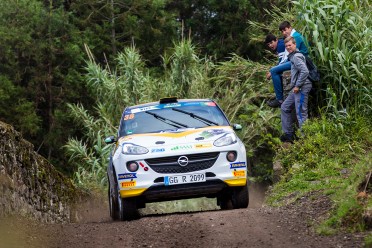
Raring away with 190 horsepower: The ADAM R2 races down the tracks on the Azores.
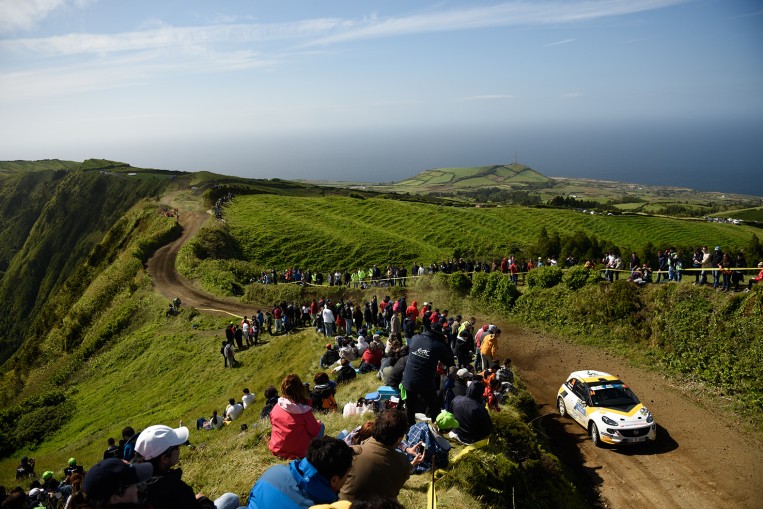
Fields of clover elsewhere? With numerous curves along tracks flanked by sheer stone walls and endless drop-offs, absolute concentration is called for.
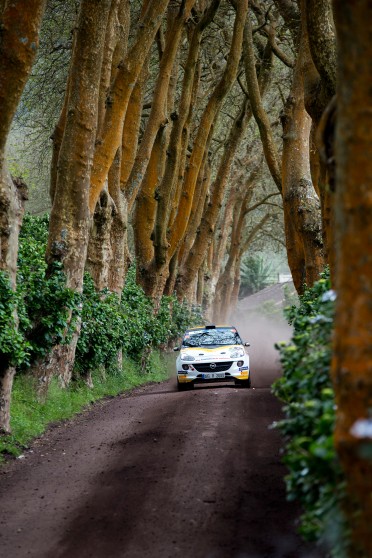
The co-driver might call out something like this during the special stage: “80 Right 3 minus cut, 50 crest full, in Left 4 long rolling, watch out, 30 branch off to Left 2 at tree.” These are from the pacenotes that a co-driver needs to read off in a few seconds. The Sete Cidades stage barely takes 20 minutes to complete in an ADAM R2 car for the ERC Junior Championship.
The co-driver is both an animating force and a mood manager. “I basically have zero seconds to see what’s coming up. You can feel it, though, and notice whether it’s right or not. It’s hard to describe,” says Katrin Becker. “For example, I sometimes give Chris additional information regarding our speed based on the interval times. I have him back off a little or push harder.” It’s a very subtle back-and-forth that they have developed over time as they have gotten to know one another better. “We’re not machines, we’re human. Together we have to find a way to perform as well as we can.” Which is why Becker can truly appreciate it when “a special stage such as Sete Cidades turns out so well, like on the first lap, when we were already 20 seconds ahead of the pack.”
45 DEGREES AND POURING RAIN
The rally on the Azores is like a proverbial ride on the razor’s edge. The weather on the archipelago is unpredictable and only compounds the situation. The slopes of the mountain were blanketed in a deep fog on Friday morning. The tracks were pocked with deep puddles from torrential downpours. Drivers were hydroplaning everywhere. If there was any pooling water, it had transformed the fine gravel surface into a muddy mess with friction coefficients that likened lubricating soaps. The teams were forced to crank up the heaters in the rally vehicles because their windshields were steaming up excessively. Everyone knows it’s no fun to ride in a car when it’s 45 degrees.
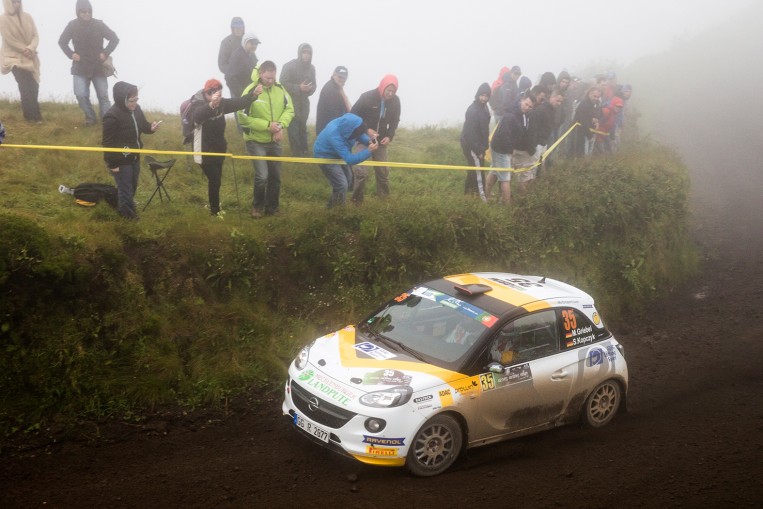
What’s the sure-fire recipe for successful communication? Timing. The co-driver needs to provide instructions over the vehicle’s intercom to prepare the driver at each point on the road. The communication between the two is fast-paced and choreographed. The driver’s attention is completely focused on keeping control of the vehicle as each instruction is given. If one arrives at the wrong moment, it will inevitably lead to a mistake, meaning lost time or, worse yet, a crash.
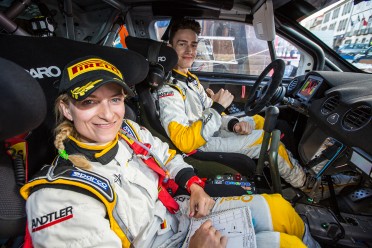
Chris Ingram obeys every beck and call of his co-driver Katrin Becker.
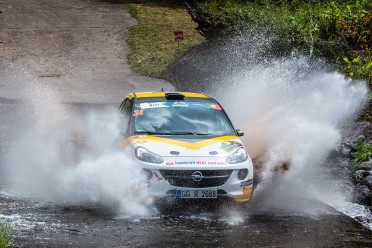
This is no Sunday drive: Strong downpours leave deep puddles on the tracks.
PUSHED TO THE LIMIT, BOTH PHYSICALLY AND MENTALLY
Just for the record: If you’re not in top physical condition, then you won’t be able to properly deal with the physical and psychological pressures of a European Championship rally. You wouldn’t be capable of winning and it would be very dangerous to boot. It’s just that simple. It holds even more true for a special stage like Sete Cidades, especially when the second run-through on Friday afternoon took place with a gorgeous sun shining down on everyone, meaning the tire grip was entirely different than the run earlier that day. The 25.6-kilometer race is chock-full of curves, meaning that the co-driver doesn’t have a chance to rest their jaws. And the driver needs to keep his wits about him to pass this stage while dancing on the edge of a volcano, attempting to also avoid having an accident.
VIRTUALLY NO ROOM FOR MISTAKES
“It’s a tremendous ability to stay so focused for such a long period of time,” admits Marijan Griebel. “There is not another rally on the European Championship calendar that has special stages lasting as long as the ones on the Azores do. And adrenaline is pumping through you constantly.” According to Griebel, the special stage of ‘Panzerplatte’ in the WRC is twice as long, but there are sections with straightaways where you can breathe out for a second, or even take a drink of water. “But in Sete Cidades, you encounter curve after curve. It’s like a bobsled run. There’s virtually no room for mistakes. If you’re ten centimeters off of the line, it could be the end for you.”
‘Crash’ Course in Rally Theory
It helps to know the basics of rally theory in order to understand how the special stage of Sete Cidades works. Each rally team analyzes and categorizes each of the numerous curves before the competition begins. It’s called ‘recce,’ which is derived from the French word for reconnaissance. The radius of the curves is noted, whereby 1 is a hairpin corner and 5 is a straightaway. The distance between checkpoints is measured. The ground surface is checked. Special features of the section of the stage where specific measures need to be taken are identified.
All of these aspects are listed in the pacenotes, which are sometimes likened to a prayer book for rally fans. Everything is written down in shorthand that looks like hieroglyphics to the uninitiated. Later on, during the race, the pace is fast. As an aside, the radius of a curve is measured without taking the weather conditions into consideration. And it is not categorized in terms of which gear to use or the speed. If it’s a ‘Right 2,’ it stays a ‘Right 2’, no matter whether the sun is out or it’s pouring rain. The driver calls the shots when it comes to deciding how to adjust the speed based on the conditions.
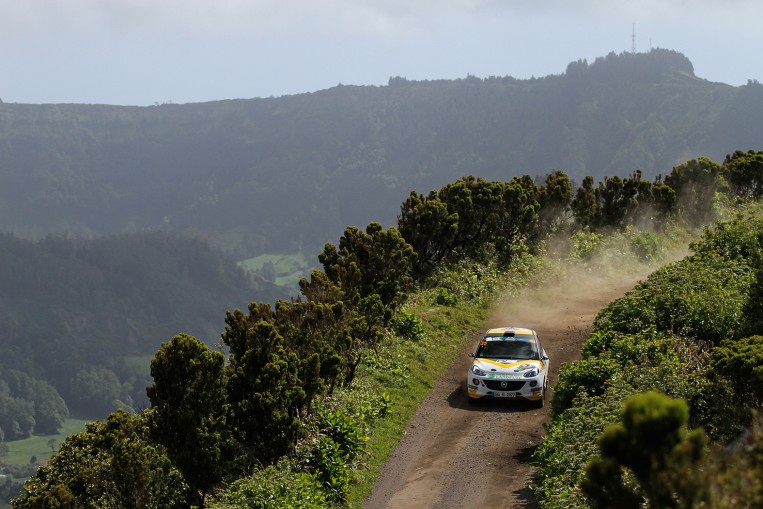
Up, up, and away: The drivers get a chance to enjoy the breathtaking beauty of the archipelago.
Unfortunately, Marijan knows only too well what he’s talking about. He was fighting for the lead in the 12th special stage when he drifted out of a right-leaning curve and hit a bale of hay on the left. The ADAM R2 swung out to the left and crashed into a tree head-on. A tiny mistake with serious consequences. Julius Tannert, a team member, had it worse when his speed demon flipped over in the final special stage (16th) and landed on its roof. Luckily Opel builds cars that fly like the wind and are rock solid. Only the drivers’ egos suffered any injury. Well, we cannot forget about the crumpled up metal, either.
INGRAM-BECKER IN THE FINAL STANDINGS
In the end, it was only Ingram-Becker who ranked second and placed in the standings for the FIA ERC Junior division. Their takeaway from this tremendous rally was grandiose.

Magnificent vegetation: There are approximately 70 types of plants endemic to the Azores.
There’s not much time to rest on their laurels. The Opel Rallye Junior team races from the gravely roadways around the volcanoes to the European mainland. At the end of June, the village of Ypers in Belgium welcomes a true mainstay in rally racing on asphalt. Expectations are high, as the brand with the lightning bolt logo took a three-way win in West Flanders in 2015.


